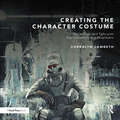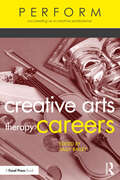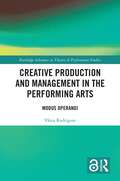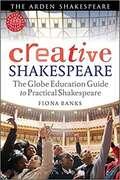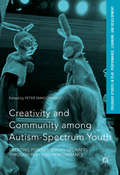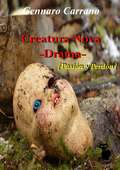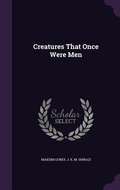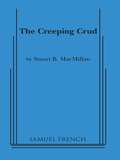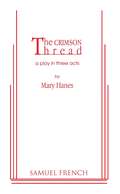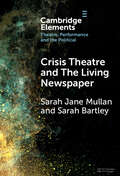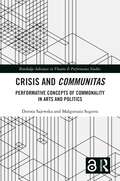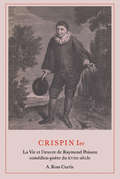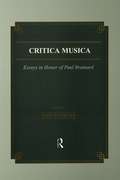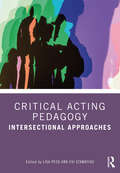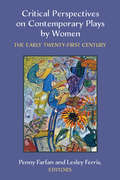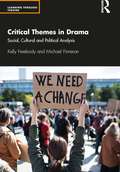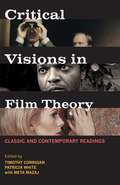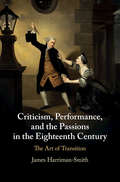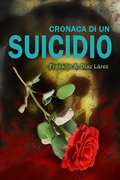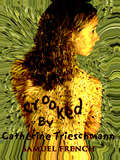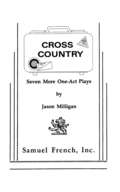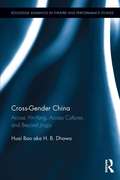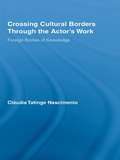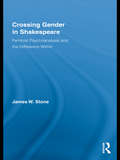- Table View
- List View
Creating the Character Costume: Tools, Tips, and Talks with Top Costumers and Cosplayers
by Cheralyn LambethMany beginning and hobbyist costumers believe that professional costume/prop builders have unlimited and specialized resources with which to ply their craft. Actually, the pros create things in much the same way that hobbyists do, working as resourcefully and creatively as possible with a limited budget. Creating the Character Costume dives into these methods to showcase how to achieve expert looks with limited means and lots of creativity. Part One explores tools, materials, and construction methods.
Creative Arts Therapy Careers: Succeeding as a Creative Professional (ISSN)
by Sally BaileyCreative Arts Therapy Careers is a collection of essays written by and interviews with registered drama therapists, dance/movement therapists, music therapists, art therapists, poetry therapists, and expressive arts therapists.The book sheds light on the fascinating yet little-known field of the creative arts therapies – psychotherapy approaches which allow clients to use creativity and artistic expression to explore their lives, solve their problems, make meaning, and heal from their traumas. Featuring stories of educators in each of the six fields and at different stages of their career, it outlines the steps one needs to take in order to find training in one of the creative arts therapies and explores the healing aspects of the arts, where creative arts therapists work, who they work with, and how they use the arts in therapy. Contributors to this book provide a wealth of practical information, including ways to find opportunities to work with at-risk populations in order to gain experience with the arts as healing tools; choosing the right graduate school for further study; the difference between registration, certification, and licensure; and the differences between a career in a medical, mental health, educational, correctional, or service institution.This book illuminates creative arts therapy career possibilities for undergraduate and graduate students studying acting, directing, playwriting, creative writing, visual arts, theatre design, dance, and music. It is also an excellent resource for instructors offering a course to prepare arts students of all kinds for the professional world.
Creative Production and Management in the Performing Arts: Modus Operandi (Routledge Advances in Theatre & Performance Studies)
by Vânia RodriguesThis volume takes stock of the ways in which the regimes of artistic creation and production intersect, lending special attention to emergent discourses and work models of producing and managing theatre, dance, and performance – through the lenses of creative producers.This book suggests that social protection failures, longstanding institutional shortcomings, and the dilemmas of social and environmental sustainability are pushing arts management and production modi operandi towards a review of its expansionist assumptions and managerial hyper-productivist processes. By documenting singular ‘counter-management’ experiences in Portugal, Belgium, France, and Brazil, this study makes a strong claim for a reassessment of the role of producers and art managers as reflective practitioners and as pivotal elements towards more sustainable artistic practices.This study will be of great interest to students and scholars in theatre and performance studies, policymakers, and cultural professionals.
Creative Shakespeare: The Globe Education Guide to Practical Shakespeare
by Fiona BanksThis unique book desribes the ways in which educational practitioners at Shakespeare's Globe theatre bring Shakespeare to life for students of all ages.The Globe approach is always active and inclusive - each student finds their own way into Shakespeare - focusing on speaking, moving and performing rather than reading. <p><p>Drawing on her rich and varied experience as a teacher, Fiona Banks offers a range of examples and practical ideas teachers can take and adapt for their own lessons. The result is a stimulating and inspiring book for teachers of drama and English keen to enliven and enrich their students' experience of Shakespeare.
Creativity and Community among Autism-Spectrum Youth: Creating Positive Social Updrafts through Play and Performance (Palgrave Studies In Play, Performance, Learning, and Development)
by Peter SmagorinskyThis edited volume explores the roles of socially-channeled play and performance in the developmental trajectories of young people who fall on the autism spectrum. The contributors offer possibilities for channels of activity through which youth on the autism spectrum may find acceptance, affirmation, and kinship with others. "Positive social updraft" characterizes the social channels through which people of difference might be swept up into broader cultural currents such that they feel valued, appreciated, and empowered. A social updraft provides cultural meditational means that include people in a current headed "upward," allowing people of atypical makeups to become fully involved in significant cultural activity that brings them a feeling of social belonging.
Creatura Nova: Pasión y perdón
by Gennaro CarranoAtemporal drama en el que autor Gennaro Carrano nos muestra los polos opuestos del ser humano: la extrema maldad y la bondad absoluta y cuyo final soprenderá al lector por la crudeza de los hechos. La historia proviene de una época lejana y de un lugar que bien podría estar más cercano de lo que imaginamos. Dos hombres nos la traen, tan distantes entre sí como el tiempo y el lugar del mismo. Felice, poeta de la alta sociedad y Valerio, un hombre sencillo. El impulso de contarla surge de un sentimiento vacilante, el deseo de comunicar la deriva de sentimientos ignorados y el impulso de deshacerse de una pesada carga. Dos hermanos son los protagonistas de la historia: Verginia y Adelfo. La miseria, la soledad, la ignorancia, la ira y la frustración pueden ser una mezcla explosiva para cualquier hombre que no esté acostumbrado a verse por dentro.
Creatures That Once Were Men
by Maksim GorkyA collection of short stories by the popular and influential Russian author, a founder of the socialist realism literary method and arguably the greatest Russian literary figure of the 20th century. He wrote stories, plays, memoirs and novels which touched the imagination of the Russian people, and was the first Russian author to write sympathetically of such characters as tramps and thieves, emphasizing their daily struggles against overwhelming odds.
Creeping Crud
by Stuart B. MacmillanComedy, High Schools / 4m, 4f / Interior / Intrepid high school reporters decide to do something about the raw sewage and medical waste that is floating up on local beaches. Their investigation reveals the culprits-- local businessmen, including the president of the school board. They go to press without faculty advisor review and are in hot water until the truth of their allegations becomes apparent.
Crimson Thread
by Mary HanesDrama / 6m, 2f / This lyrical three act drama is a story of love, loss and survival told through three generations of Irish sisters. The play spans the years from 1869 to 1911. Scenes shift from a poor farm in Ireland to the fishing port of New Bedford, Massachusetts, and climax in New York City just after the deadly Triangle Shirtwaist Company fire. As the daughters of McDermotts, Connellys and Kenndys pass against this colorful panorama, one thing is paramount in their lives: family. It is the thread that binds them together and strengthens them to survive against all odds.
Crisis Theatre and The Living Newspaper (Elements in Theatre, Performance and the Political)
by Sarah Jane Mullan Sarah BartleyCrisis Theatre and The Living Newspapers traces a history of the living newspaper as a theatre of crisis from Soviet Russia (1910s), through the Federal Theatre Project of the Great Depression in America (1930s), to Augusto Boal's teatro jornal in Brazil (1970s), and its resonance with documentary forms deployed in the final years of apartheid in South Africa (1990s), up until the present day in the UK (2020s). Across this Element, the author is interested in what a transnational and transhistorical examination of the living newspaper through the lens of crisis reveals about the ways in which theatre can intervene in our collective social, economic and political life. By holding these diverse examples together, the author asserts the Living Newspaper as a form of Crisis Theatre.
Crisis and Communitas: Performative Concepts of Commonality in Arts and Politics (Routledge Advances in Theatre & Performance Studies)
by Małgorzata Sugiera Dorota SajewskaThis book is a critical, transdisciplinary examination of a broad range of philosophical ideas, theoretical concepts, and artistic projects of community in the 20th and 21st century in the context of global/local social and political changes. This volume opens new vitas by focusing on carefully selected instances of multipronged crises in which existing concepts of commonality are questioned, reformulated, or even speculatively designed with a (better) future in view. As many authors of this volume argue, in the face of today’s unprecedented global ecological and economic challenges speculative design is of utmost importance as it can foster alternative, unthought-of forms of connectivity that go far beyond progressivist narratives of nation, corporation, and nuclear family. Focusing on the situations of upheaval, both historical and fabulated, the collection not only examines how multipronged crises trigger antagonisms between egalitarian forms of communitas and the normative concept of the nation (and other normative forms of communities) as a community that separates and excludes. It also looks closely at philosophical and artistic projects that strive to go beyond the dichotomies and typically extrapolated utopias, envisaging new political economies, ways of living and alternative relational structures. It will be of great interest to students and scholars in performance studies, cultural studies, political studies, media studies, postcolonial and decolonial studies, critical anthropology.
Crispien Ier: La Vie et l'œuvre de Raymond Poisson comédien-poète du XVIIe siècle
by A. Ross CurtisRaymond Poisson, a contemporary of Molière, was the leading comic actor with the troupe of the Hôtel de Bourgogne and later at the Comédie Française during the first five years of its existence. He popularized one of the French stage's best-loved stock characters, the impudent servant Crispin, while finding time to supply his troupe with short comedies in which he himself starred. This study is thoroughly documented and reflects the author's detailed knowledge of, and interest in, the period. It establishes Poisson's place in theatrical history, and illuminates a whole tradition in French theatre in the seventeenth century.
Critica Musica: Essays in Honour of Paul Brainard (Musicology)
by J. KnowlesThis is Volume 18 of eighteen in a book series on Musicology. Originally published in 1996, this is a collection of essays in honor or Paul Brainard. Critica Musica-thinking critically about music-is at the heart of Paul Brainard's long career, and of his legacy to his students, colleagues, and friends. As a scholar, performer, and teacher, Professor Brainard has embodied a thorough, meticulous, and reasoned approach to music and scholarship that has set a high standard for all who have come in contact with him.
Critical Acting Pedagogy: Intersectional Approaches (Routledge Advances in Theatre & Performance Studies)
by Lisa Peck Evi StamatiouCritical Acting Pedagogy: Intersectional Approaches invites readers to think about pedagogy in actor training as a research field in its own right: to sit with the complex challenges, risks, and rewards of the acting studio; to recognise the shared vulnerability, courage, and love that defines our field and underpins our practices. This collection of chapters, from a diverse group of acting teachers at different points in their careers, working in conservatoires and universities, illuminates current developments in decolonising studios to foreground multiple and intersecting identities in the pedagogic exchange. In acknowledging how their positionality affects their practices and materials, 20 acting teachers from the United Kingdom, the United States, Europe, and Oceania offer practical tools for the social justice acting classroom, with rich insights for developing critical acting pedagogies. Authors test and develop research approaches, drawn from social sciences, to tackle dominant ideologies in organisation, curriculum, and methodologies of actor training.This collection frames current efforts to promote equality, diversity, and inclusivity in the studio. It contributes to the collective movement to improve current educational practice in acting, prioritising well-being, and centering the student experience.
Critical Perspectives on Applied Theatre
by Helen Nicholson Hughes, Jenny and Nicholson, Helen Jenny HughesAs the twenty-first century moves towards its third decade, applied theatre is being shaped by contemporary economic and environmental concerns and is contributing to new conceptual paradigms that influence the ways in which socially engaged art is produced and understood. This collection offers fresh perspectives on the aesthetics, politics and histories of applied theatre. With contributions from leading scholars in the field, the book illuminates theatre in a diverse range of global contexts and regions. Divided into three sections - histories and cultural memories; place, community and environment; and poetics and participation - the chapters interweave cutting-edge theoretical insights with examples of innovative creative practice that traverse different places, spaces and times. Essential reading for researchers and artists working within applied theatre, this collection will also be of interest to those in theatre and performance studies, education, cultural policy, social history and cultural geography.
Critical Perspectives on Contemporary Plays by Women: The Early Twenty-First Century
by Lesley Ferris Penny FarfanThis book foregrounds some of the ways in which women playwrights from across a range of contexts and working in a variety of forms and styles are illuminating the contemporary world while also contributing to its reshaping as they reflect, rethink, and reimagine it through their work for the stage. The book is framed by a substantial introduction that sets forth the critical vision and structure of the book as a whole, and an afterword that points toward emerging currents in and expansions of the contemporary field of playwriting by women on the cusp of the third decade of the twenty-first century. Within this frame, the twenty-eight chapters that form the main body of the book, each focusing on a single play of critical significance, together constitute a multifaceted, inevitably partial, yet nonetheless integral picture of the work of women playwrights since 2000 as they engage with some of the most pressing issues of our time. Some of these issues include the continuing oppression of and violence against women, people of color, LGBTQ+ people, and ethnic minorities; the ongoing processes of decolonization; the consequences of neoliberal capitalism; the devastation and enduring trauma of war; global migration and the refugee crisis; the turn to right-wing populism; and the impact of climate change, including environmental disaster and species extinction. The book is structured into seven sections: Replaying the Canon; Representing Histories; Staging Lives; Re-imagining Family; Navigating Communities; Articulating Intersections; and New World Order(s). These sections group clusters of plays according to the broad critical actions they perform or, in the case of the final section, the new world orders that they capture through their stagings of the seeming impasse of the politically and environmentally catastrophic global present moment. There are many other points of resonance among and across the plays, but this seven-part structure foregrounds the broader actions that drive the plays, both in the Aristotelian dramaturgical sense and in the larger sense of the critical interventions that the plays creatively enact. In this way, the seven-part structure establishes correspondences across the great diversity of dramatic material represented in the book while at the same time identifying key methods of critical approach and areas of focus that align the book’s contributors across this diversity. The structure of the book thus parallels what the playwrights themselves are doing, but also how the contributors are approaching their work. Plays featured in the book are from Canada, Australia, South Africa, the US, the UK, France, Argentina, New Zealand, Syria, Brazil, Italy, and Austria; the playwrights include Margaret Atwood, Leah Purcell, Yaël Farber, Paula Vogel, Adrienne Kennedy, Suzan-Lori Parks, debbie tucker green, Lisa Loomer, Hélène Cixous, Anna Deavere Smith, Lola Arias, Lisa Kron and Jeanine Tesori, Marie Clements, Quiara Alegría Hudes, Alia Bano, Holly Hughes, Whiti Hereaka, Julia Cho, Liwaa Yazji, Grace Passô, Dominique Morisseau, Emma Dante, Frances Ya-Chu Cowhig, Lynn Nottage, Elfriede Jelinek, Caryl Churchill, Colleen Murphy, and Lucy Kirkwood. Encompassing several generations of playwrights and scholars, ranging from the most senior to mid-career to emerging voices, the book will be essential reading for established researchers, a valuable learning resource for students at all levels, and a useful and accessible guide for theater practitioners and interested theater-goers.
Critical Themes in Drama: Social, Cultural and Political Analysis (Learning Through Theatre)
by Kelly Freebody Michael FinneranCritical Themes in Drama is concerned with the relationship between drama and the current socio-political context. It builds on and contributes to ongoing scholarly conversations regarding the use, benefit, challenges and opportunities for drama and theatre as a social, cultural, educational and political act. The intention of this book is to canvas current theory and practice in drama, to provide an extended examination of how drama as a pro-social practice intersects with socio-cultural institutions, to link critical discourse and examine ways drama may contribute to a broader social justice agenda. Authors draw on a variety of theoretical tools from the fields of sociology, anthropology and cultural studies. This combines with an exploration of work from drama practitioners across a variety of countries and practices to provide a map of how the field is shaped and how we might understand drama praxis as a social, cultural and political force for change. This book offers drama scholars, practitioners, researchers and teachers a critical exploration which is both hopeful and critical; acknowledging the complexities and potential pitfalls, while celebrating the opportunities for drama as a practice for social action and positive change.
Critical Visions in Film Theory: Classic and Contemporary Readings
by Patricia White Timothy CorriganEmbracing groundbreaking approaches without ignoring the history of classical film theory, this book encompasses the broader, more inclusive perspective of film theory today, focusing on topics such as race, gender and sexuality, and new media.
Criticism, Performance, and the Passions in the Eighteenth Century: The Art of Transition
by James Harriman-SmithGreat art is about emotion. In the eighteenth century, and especially for the English stage, critics developed a sensitivity to both the passions of a performance and what they called the transitions between those passions. It was these pivotal transitions, scripted by authors and executed by actors, that could make King Lear beautiful, Hamlet terrifying, Archer hilarious and Zara electrifying. James Harriman-Smith recovers a lost way of appreciating theatre as a set of transitions that produce simultaneously iconic and dynamic spectacles; fascinating moments when anything seems possible. Offering fresh readings and interpretations of Shakespearean and eighteenth-century tragedy, historical acting theory and early character criticism, this volume demonstrates how a concern with transition binds drama to everything, from lyric poetry and Newtonian science, to fine art and sceptical enquiry into the nature of the self.
Cronaca di un Suicidio
by Franklin A. Díaz LárezQuesta è la storia delle circostanze, raccontate in prima persona dal protagonista, che hanno portato un giovane immobiliarista a commettere il peggior atto che una persona possa commettere contro sé stessa: togliersi la vita. <P><P>È la spiegazione dettagliata degli avvenimenti che l'hanno portato all'ossessione e alla follia. <P><P>La storia inizia con il cambio di sede di un ufficio, in un luogo dove il nostro protagonista conosce colei che sarà la causa dei suoi deliri: una bella giovane di sedici anni appena compiuti. <P>Fin dal primo giorno in cui si conoscono, i due rimangono completamente stregati dagli influssi dei loro sentimenti amorosi. Tuttavia, il passare del tempo, il loro vincolo di parentela (sono cugini), l'influenza nociva della madre della ragazza e la sua immaturità fanno sì che le cose prendano una piega che si rivelerà fatale.
Crooked
by Catherine TrieschmannDramatic Comedy / 3f Fourteen year old Laney arrives in Oxford, Mississippi with a twisted back, a mother in crisis and a burning desire to be writer. When she befriends Maribel Purdy, a fervent believer in the power of Jesus Christ to save her from the humiliations of high school, Laney embarks on a hilarious spiritual and sexual journey that challenges her mother's secular worldview and threatens to tear their fragile relationship apart. "The work of a big accomplished writer's voice...a gem of a discovery." -The New York Times "Gorgeous almost beyond belief." -The London Times "This is a wonderfully neat play, at once simple and complex, grappling with big issues - matters of faith, fantasy and the flesh - while keeping its sneakers firmly planted on the suburban topsoil of adolescent angst and domestic frictions." - The Daily Telegraph
Cross Country
by Jason MilliganSeven More One-Act Plays Contents Clara and the Gambler Class of '77 Life After Elvis Money Talks The Quality of Boiled Water Road Trip Shore Leave
Cross-Gender China: Across Yin-Yang, Across Cultures, and Beyond Jingju (Routledge Advances in Theatre & Performance Studies)
by Huai BaoCross-Gender China, the outcome of more than twenty years of theatrical and sociological research, deconstructs the cultural implications of cross-gender performance in today's China. The recent revival in male-to-female cross-gender nandan performance in Chinese theatre raises a multitude of questions: it may suggest new gender dynamics, or new readings of old aesthetic traditions in new socio-cultural contexts. Interrogating the positions of the gender being performed and the gender doing the performing, this volume gives a broad cultural account of the contexts in which this unique performance style has found new life.
Crossing Cultural Borders Through the Actor's Work: Foreign Bodies of Knowledge (Routledge Advances in Theatre & Performance Studies)
by Cláudia Tatinge NascimentoA sophisticated analysis of how the intersection of technique, memory, and imagination inform performance, this book redirects the intercultural debate by focusing exclusively on the actor at work. Alongside the perspectives of other prominent intercultural actors, this study draws from original interviews with Ang Gey Pin (formerly with the Workcenter of Jerzy Grotowski and Thomas Richards) and Roberta Carreri (Odin Teatret). By illuminating the hidden creative processes usually unavailable to outsiders--the actor’s apprenticeship, training, character development, and rehearsals--Nascimento both reveals how assumptions based on race or ethnicity are misguiding, trouble definitions of intra- and intercultural practices, and details how performance analyses and claims of appropriation fail to consider the permanent transformation of the actor’s identity that cultural transmission and embodiment represent.
Crossing Gender in Shakespeare: Feminist Psychoanalysis and the Difference Within (Routledge Studies In Shakespeare Ser. #3)
by James W. StoneIn this book, Stone effects a return to gender, after many years of neglect by Twenty-First-Century critics, via a methodology of close reading that foregrounds moments of sexual decentering and disequilibrium within the text and in the interstices of the dialogue between Shakespeare and his critics. Issues addressed range from the cross dressing of Viola and Imogen to the cross gartering of Malvolio, the sound of "un" and the uncanny lyric narcissism of Richard II, Hamlet’s misogyny, androgyny, and the poison of marital/political "union," Othello’s fears of impotence, rumors of Antony’s emasculation versus the militant yet nurturing triumphalism of Cleopatra’s suicide, and Posthumus’s hysterical reaction to the "woman’s part" in himself and his compensatory fantasies of parthenogenesis. Stone unpacks ideologically powerful but unsustainable male claims to self-identity and sameness, set over against man’s type-gendering of women as the origin of divisive sexual difference, discord, and the dissolution of marriage. Men who blame women for the difference that divides and weakens their sense of unity and sameness to oneself are unconscious that the uncanny feminine is not outside the masculine, its reassuring canny opposite; it is inside the masculine, its uncanny difference from itself.
